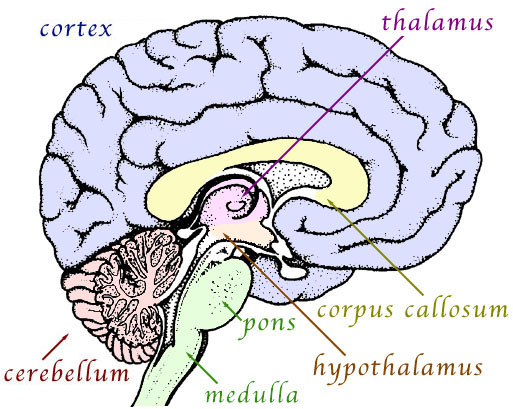BIOL 1400 -- Lecture Outline 38
"The question of whether a computer can think is no more interesting than the
question of whether a submarine can swim." -- E. W. Dijkstra
I. Nervous system: principal subdivisions
- A. Central nervous system (CNS): brain and spinal cord, the
"central switchboard" or "central processing units"
- B. Peripheral nervous system (PNS): nerves connecting the CNS with all
parts of the body, carrying sensory information and motor (movement) impulses to and
from the CNS.
- We can subdivide the PNS into several subsystems. One of these is the
autonomic nervous system, which controls automatic functions that
are outside of conscious awareness. (Thanks to the autonomic nervous system,
you don't have to think about breathing, peristalsis, making your heart beat, etc.)
- The autonomic nervous system includes two further subdivisions, which connect
various internal organs with the CNS:
- a. The sympathetic nervous system -- prepares body for "fight or flight".
When active, it causes digestion to stop, heart rate to speed up, bronchi to expand,
liver to release glucose, etc.
- b. The parasympathetic nervous system -- prepares body to "rest and digest".
When active, it causes digestion to start, heart rate to slow down, bronchi to contract,
liver to store glucose, etc.
II. Structure of the brain -- highly simplified!!!

External view of the brain
- A. Externally visible parts
- Cortex -- largest part; highly wrinkled. Includes: sensory and motor
centers; higher thought; planning, foresight; creativity, etc.
- Damage to cortex
might include loss of sensation, loss of motion (paralysis), inability to plan,
disturbances of thought, or many other problems, depending on what part is affected
- Cerebellum -- coordinates motion with senses.
- Damage to cerebellum
may result in uncoordination ("drunken sailor" movements)
- Medulla and pons -- control autonomic functions. (Some of
the nerves of the autonomic nervous system connect with the medulla; those are
those whitish stumps that you see sticking out from the medulla in the diagram.)
The pons also acts as a "relay station" between the cortex and cerebellum.
- Damage to these might result in loss of breathing, irregular heart rate or
blood pressure, digestive problems, and so on.)

Cross-section of the brain
- B. Internally visible parts
- The cortex is divided into two hemispheres, left and right. The left hemisphere
tends to control rational, logical functions and speech; the right tends to control
creativity, intuition, etc. (This is not an absolute dichotomy.)
- Connecting the hemispheres is a thick band of packed neurons, the corpus
callosum.
- Below the corpus callosum, the thalamus is primarily a "relay station"
and "processing center" between the cortex and the rest of the brain.
- Below the thalamus, the hypothalamus functions in emotional response,
sex drive (and possibly sexual orientation???), hunger, thirst, etc. It's also a
control center for the autonomic nervous system, working with and through the
medulla.
Go to Previous Notes |
Return to Lecture Schedule |
Return to Syllabus |
Contact the Prof |
That's All There Is, There Ain't No More


